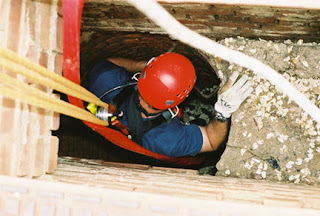Tuesday, September 9, 2008
A confined space is any space: 1) that has limited or restricted means of entry or exit; 2) is large enough for a person to enter to perform tasks, and 3) is not designed or configured for continuous occupancy. [1] A utility tunnel, the inside of a boiler (only accessible when the boiler is off), the inside of a fluid storage tank, a septic tank that has contained sewage, and a small underground electrical vault are all examples of confined spaces. The exact definition of a confined space varies depending on the type of industry. That is, confined spaces on a construction site are defined differently than confined spaces in a paper mill. Confined spaces that present special hazards to workers, including risks of toxic or asphyxiant gas accumulation, fires, falls, flooding, and entrapment may be classified as permit-required confined spaces depending on the nature and severity of the hazard.
In the U.S., entry into permit-required confined spaces must comply with regulations promulgated by the Occupational Safety and Health Administration. These regulations include developing a written program, issuing entry permits, assigning attendant(s), designating entrants, and ensuring a means of rescue.
According to Occupational Safety and Health Administration a permit-required confined space (permit space) has the three characteristics listed above (which define a confined space) and one or more of the following:
- Contains or has the potential to contain a hazardous atmosphere
- Contains a material that has the potential for engulfing the entrant
- Has an internal configuration that might cause an entrant to be trapped or asphyxiated by inwardly converging walls or by a floor that slopes downward and tapers to a smaller cross section
- Contains any other recognized serious safety or health hazards.
In addition to the hazards posed by the design of the space, work activities can also pose serious safety hazards (heat, noise, vapors, etc.) that must be taken into account when identifying safety measures that must be taken.
Entry certification
In many situations, certification of non-hazardous atmosphere by a trained or competent person is required before personnel may enter a confined space without the use of a respirator. In the United States Navy, that person is the designated shipboard gas-free engineer. Certification in civilian settings can be performed by an Entry Supervisor who, under O.S.H.A. regulations is designated by the employer and ensures that the space is safe to enter and all hazards are controlled.
In the United States, agricultural and construction operations are exempted from regulations governing permit-required confined spaces (which is specific to general industry), but they are still required to identify and control confined space hazards.
Injuries/Fatalities
Injuries and fatalities involving confined spaces are frequent and often involve successive fatalities when would-be rescuers succumb to the same problem as the initial victim. One example was in 2006 at the decommissioned Sullivan Mine in British Columbia, Canada when one initial victim and then three rescuers all died.
According to data collected by the U.S. Department of Labor, Bureau of Labor Statistics, Census of Fatal Occupational Injuries program, fatal injuries in confined spaces fluctuated from a low of 81 in 1998 to a high of 100 in 2000 during the five-year period, averaging 92 fatalities per year.[2]

0 Comments:
Post a Comment